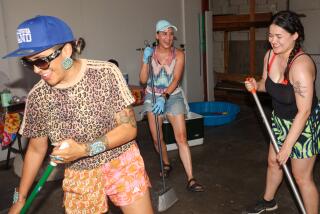Her People, Her Purpose
- Share via
All Peoples Christian Center in South-Central Los Angeles is a bit like an enchanted castle. In disguise. On a street lined by small bungalows with front-porch gliders and smatterings of indefatigable geraniums, the center is very large, very beige and not at all charming. Inside, the waiting area, with its fliers in English and Spanish announcing state health insurance and free baby food, is small and beige, with doors in every wall. Through these doors are hallways, narrow and still, and many more doors.
A twist of the knob reveals the enchantment--whole other worlds of color and life. A seniors’ lounge, complete with sofas and tables and a baby grand piano. Well-stocked classrooms for foundering high school students, for after-school programs, for English-as-a-second-language classes. A computer lab with a half-dozen wide-awake screens. An arts and crafts room with tables silted and stained by clay and paint. A gymnasium, a library, a reading room, a chapel.
Children of all ages move through the doors, through the rooms, on their way to lunch, trying not to run, to make too much noise, failing extravagantly.
Another door opens and the sound of running grows softer, lighter, and there is the day-care center, four glorious rooms of it, vibrating with movement and color--hand-painted butterflies flutter from one ceiling, construction paper ladybugs crawl up one wall, toys and cubbies and blankets and drawings and everywhere children, smiling and laughing and swinging around in their chairs to wave. “Sandeeeeee. Hi, Sandy. Hi, Sandy, Sandy, Sandy. Hiiiii.”
The keeper of this castle is Saundra Bryant, 43, executive director of the center for 16 years. Reaching out to pat the children, to hug and talk to them, she seems more participant than director. But after they have dispersed, she rattles off the facts with the efficiency of a veteran grant-request writer. “We have 73 children here, ages 2 to 5. Our fees are on a sliding scale, but most are here at no cost. The median income in this area is $18,000--for a family of four--compared with L.A. County’s median of $32,000. We have a long waiting list.”
Bryant speaks these and other unsettling numbers in a gentle, straightforward tone. One hundred and twenty-five families rely on the center’s food distribution program for their monthly staples. Forty-five students unable to attend high school--because they were failing, or working, or single moms, or in gangs, or just bored--enrolled in its high school continuation program. Five thousand in all avail themselves of some of the center’s services.
These are the facts of her people. And they are most definitely her people. Bryant once went to day care here herself, grew up in the day camps and after-school classes of the center, tearing around its playground, running through its halls. Her mother worked here for years, retired, then volunteered for a year after that.
Bryant has watched this neighborhood shift, then shift again, from predominantly Japanese to African American to Latino. Some have stayed in this oft-troubled enclave because they could not get out; Bryant left, went to college, graduate school, and then came back.
“I know all these kids. I went to school with their parents, grew up knowing their grandparents,” she says. “This is my church, and the center is my mission on Earth right now. The center is my home.”
That much is clear as she illuminates room after room, explaining its use, its history, then extinguishes the light. Often when there are people still working there.
“Oops,” she says, laughing, flipping the switch back on. “Sorry, sorry. You can see I pay the bills here; everywhere I go, I turn off the lights.”
She tells the history of the center fondly, familiarly, as one would a family myth. And yet it is as much the story of the city.
Founded by
Japanese Group
It began in 1942 as a community center founded by the Japanese Christian Institute, only to be emptied when the government forced all resident Japanese into internment camps. The Rev. Dan Genung was dispatched from the Christian Church (Disciples of Christ) missionary society to start a church. When he and his wife arrived, they realized that what the remaining community needed, with all the women working in various war industry factories, was a day-care center. All People’s Christian Church was chartered in 1946.
“They called it All Peoples after Isaiah 56:7,” which says, “For mine house shall be called a house of prayer for all people,” Bryant explains. “It was founded as a multiracial church during a time when that was not necessarily an idea taken up by a lot of people.”
After the war, many Japanese returned, some to work at the center. Two of them--Joe Ide and Akira Suzuki--remained for years; their photos hang in places of honor on the walls of the center. Ide, who died a few years ago, was a former executive director who, among other things, maintained the center’s archives that include fastidious photo albums dating to the 1940s. Suzuki still volunteers, teaching English and Spanish classes to seniors.
The neighborhood grew increasingly mixed, with African Americans the majority. When Bryant’s family moved into the neighborhood, it was en masse.
“My parents were from the same tiny town in Texas,” she says. “But they didn’t get together till they both moved to L.A. When they bought the house on 20th Street, my grandmother lived right next door and my half-sister lived right up the street. It was all family.”
Bryant credits her mother, who lives in Las Vegas, and the staff of the center, with her ability to rise above society’s expectations of her as a black girl from the east side.
“People looked down on this neighborhood,” she says, “but my mother always taught me I was just as good as anyone else. It’s not like there weren’t drugs or teen pregnancy or gangs when I was growing up, and I certainly made mistakes. But there were people here, at the center, who always put me back on my horse, who kept me from making irreversible mistakes. And I knew that I wanted to give that back.”
She went to college at Cal Poly Pomona but traveled to the University of Tennessee to get her graduate degree in social work. There was no question about her return.
“Well, it’s not like I was going to stay in Knoxville,” she says, grinning. “And I remembered this teacher I had in middle school who I thought was teaching us because he cared. One day he told me he had all these student loans and he could defer them if he taught two years in the inner city. After two years, he was leaving. It made me so mad. See, I wanted to come back and make sure that all this, all the things that helped me, continued.”
Income From
Varied Sources
“All this” is a lot of work. The money comes from the inevitable patchwork of sources--57% from individuals and corporations, 33% from city and federal government grants, and 10% from the United Way. Bryant not only pays the bills, she hires the staff, gets the grants, balances the books, creates new programs, mentors students . . . the list is endless. And in two languages--more than 60% of the staff is bilingual.
And running the center is just part of what Bryant does. She also sits on the board of the church, was the first woman president of the L.A. Host Lion’s Club and organizes community actions, such as the recent successful drive to prevent the opening of another neighborhood bar.
Sixteen years is a long time to work at any job. Much less a job in the nonprofit sector. Bryant puts in a 60- to 75-hour week, and that’s not counting the phone calls and faxes during the few days she manages to take off.
There are many rewards, from the children, from the community; and awards, including the United Way Charity of the Year in 1998, and this year’s Lewis Hine Award bestowed by the National Child Labor Committee. But what Bryant really needs is a break.
A Chance to
Rejuvenate
Which she got just last month when she received a $25,000 Durfee Sabbatical Award. Given annually by the Durfee Foundation to six outstanding leaders in L.A.’s nonprofit community, the award recognizes the need such people have for some time off. The money is to be used to provide a nonworking vacation during which the recipient can relax and rejuvenate.
“Saundra is the perfect example of the people we want to recognize,” says Claire Peeps, executive director of the foundation, which also supports arts and education programs. “She is an extraordinary woman who has absolutely made a difference in this city.”
And as much as she loves the center, Bryant says she’s really looking forward to taking three months off with her husband, Leo Bryant, a data systems coordinator for the L.A. district attorney’s office. The couple plans to go to the Caribbean and the Hawaiian island of Kauai, and spend time with their granddaughter, who lives in Pismo Beach.
But she’ll be back, if only to help train her administrative assistant, Gricelda Velazquez, to be her successor one day.
“I tease her about it,” Bryant says. “But it would be my happiest day. What I see here proves that help doesn’t have to come from the outside. This neighborhood has talent and resources. My job is to see that this continues. Because,” she says, drawing a breath, and gazing out at the street she has watched for so long, “when I’m looking at these kids, I’m looking at myself.”
Mary McNamara can be reached by e-mail at [email protected].
More to Read
Sign up for Essential California
The most important California stories and recommendations in your inbox every morning.
You may occasionally receive promotional content from the Los Angeles Times.











